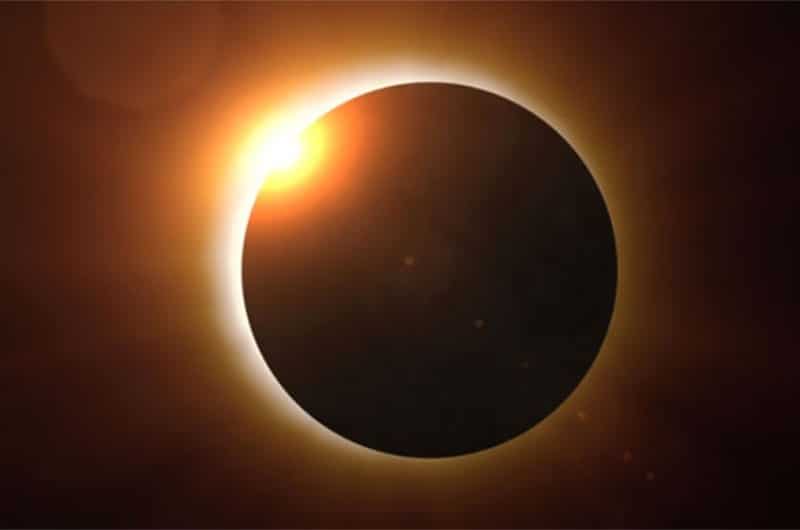by Sanibel Chai
The total solar eclipse occuring this Monday, August 21 is particularly rare because it is the first time the path of totality exclusively crosses the continental United States from coast to coast in nearly a century—the last time was on June 8, 1918. It is also the first continent-wide eclipse to be visible only from the United States since 1776. Nantucket will experience only a partial eclipse, with maximum eclipse of about 70 percent. All week Nantucket’s Maria Mitchell Association (MMA) has been offering a programs and workshops to celebrate this astronomical event.
Because you should never look directly at the sun without proper eyewear, the Maria Mitchell Association is providing free solar glasses for safe viewing, which are available for pickup at 4 Vestal Street.
This Sunday, August 20 from 2 to 3 pm, MMA interns and staff will hold a free Eclipse Workshop at their Vestal Street Observatory. The workshop will explain the science behind solar eclipses and provide a variety of methods to safely observe this rare phenomenon.
Maria Mitchell Association’s Solar Eclipse Week culminates the day of the event with an Eclipse Party at 4 Vestal Street, an easy walk from town. They will close down a section of Vestal Street for an outdoor observation post where visitors can safely view the eclipse as they enjoy festivities with punch and cookies. This free event will give participants the opportunity to view live feeds of the eclipse from NASA. Participants can have their eclipse questions answered and view the sun through the MMA’s solar telescope. This telescope has a special filter built in that will protect eyes. Do not point a regular telescope at the sun to view the eclipse. At the party, you can also view the solar eclipse through several means of projection. Rather than looking up at the sun, you can watch the eclipse through a Sun Spotter, which uses lenses and mirrors to project the eclipse onto a white surface.
The MMA’s astronomer, Dr. Regina Jorgenson, will join the party remotely via Skype from Oregon, where she will be to experience the total solar eclipse.
“Although I would love to be on Nantucket to view the partial eclipse with everyone, I am thrilled to be able to travel to Oregon to experience my first total solar eclipse, much as Maria Mitchell did when she travelled to Colorado. Of course, I won’t be travelling by train and open wagon, but I will be leaving from Nantucket as Maria did. I hope to see you all at the Vestal Street Observatory via Skype!”, says Dr. Jorgenson, Director of Astronomy.
There are four main types of solar eclipses: Partial, Annular, Total, and Hybrid. According to NASA, total solar eclipses occur once every 12 to 18 months somewhere on Earth, while partial solar eclipses – when the moon blocks only part of the sun – occur more frequently, though visibility varies. If Monday is a sunny day on Nantucket, viewers will most likely notice the eclipse and it will appear to be temporarily cloudy; from here, the sun will not be completely eclipsed out at any time. The maximum eclipse (the point at which the largest portion of the sun will be eclipsed as seen from Nantucket) will take place at 2:46 pm, so be sure to arrive at the Eclipse Party beforehand. Distance from the sun and the moon determines how “total” the eclipse will be for a given location. A total solar eclipse is when the moon completely blocks the sun, allowing for the solar corona to be seen. The solar corona is a reddish outline around the sun that is usually invisible because it is too faint compared with the brightness of the sun. Oregon is in the path of totality so during the maximum eclipse the entire sky will go dark as the sun is fully covered. Other places in the path of totality are parts of Idaho, Wyoming, Nebraska, Kansas, Missouri, Illinois, Kentucky, Tennessee, Georgia, and South Carolina.
This solar eclipse is a great learning opportunity as well as an historical event. The slate of events hosted by Maria Mitchell Association offers something for everyone, from curious children to the veteran astronomy buff. Take advantage of Nantucket’s lucky geography and head out to see this once in a lifetime phenomenon.
The Maria Mitchell Association was founded in 1902 to honor the legacy and achievements of America’s first female astronomer, Maria Mitchell. She garnered worldwide fame for discovering a comet over Nantucket in October 1847. She then went on to become the first professor at Vassar College. The Maria Mitchell Association continues to preserve her legacy of scientific achievement and to carry on her passion for hands-on learning. Today, the Maria Mitchell Association operates two observatories (Loines and the Vestal Street Observatory), as well as the MMA Aquarium, the Natural Science Museum, and the birthplace of Maria Mitchell. For more information, visit the MMA’s website at www.mariamitchell.org.
For more events around the eclipse and throughout the year, visit our Events Calendar.